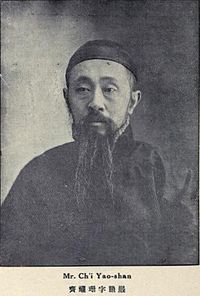Qi Yaoshan (Chinese: 齊耀珊; 1865[1] - February 15, 1954[2]), courtesy name Zhaoyan, was a statesman and government official in the Qing dynasty and Republic of China. He was born in Yitong County (now Sitaizu Village, Mengjialing Town, Lishu County),[3][4] Jilin.

Qing dynasty
editQi Yaoshan was born in Jilin in 1865. In 1889, he had become a Juren in the Imperial Examination system. In the following year, he became a scholar of Genshenke.[5] In May 1890, he was awarded the position of Chancellor (Zhongshu) of the Cabinet. He served as a copy-writer serving the Governor of Hubei, the Zongban (high organizational rank) to the Baojia of Wuchang, the Prefect of Yichang Prefecture, and at the General Office of the Qingzhang Bureau of Hankou.
Towards the final years of the reign of the Guangxu Emperor, Qi was promoted to the position of administrator of Jingyi Circuit and Hanhuangde Circuit in Hubei. After this, he served at the General Office of Honghanguan at the Public Relations Office, as well as at the head of the Hubei Provincial Government Supervising and Training Office and as a manager of academic affairs in Hubei.[6][7][8]
Republican Era
editIn 1913, Qi served as the director of the Beijing Salt Production Affairs Preparation Office. In March of the following year, he served as a delegate to the Republic of China Constitutional Convention. In May, he was appointed to the National Assembly.[6][7][8]
In 1918, Qi was appointed Governor of Zhejiang Province. In 1920, he was appointed Governor of Shandong Province. In 1921, he served as the Chief Cabinet Secretary of Jin Yunpeng and the Prime Minister of the Famine Relief Society. In June, he began supervising the affairs of Beijing Normal University. In July, he was appointed to the position of President of Shangwu (Commercial) Bank. In December, he entered the Cabinet of Agriculture and Commerce under Liang Shiyi, as well as becoming the Minister of Education. In 1922, Qi was appointed Chairman of the Grain Survey Committee. In April, he was removed from his position as Minister of Education, and in June, he was removed from his position as being the President of the Shangwu Bank. In 1927, he served as a member of the Political Discussion Committee of the Anguojun Government under Zhang Zuolin, as well as becoming a researcher of Beijing Ancient Studies University.[6][7][8]
On February 15, 1954, Qi died in Taipei.[2] His family consisted of his older brother, Qi Yaolin, and his younger brother, Qi Yaocheng.
References
edit- ^ Edited by Xu, Youchun. Dictionary of Figures in the Republic of China - Revised Edition, p. 2317 refers to Qi's birth year as 1865. Who's Who in China 3rd ed., p.162 records his year of birth as 1867. The Records of the Law Conference (1915) records that he was 51 years old. Because of this, he should have been born in 1864. So, 1865 serves as an average between the birth years.
- ^ a b Tan, Renfeng. Tan Renfeng Ji. Changsha People's Press, 2008. p. 37.
- ^ Qixi Renwen. 一辆木推车推出两位省长13名知县. 昌邑之窗 Archived 2016-10-06 at the Wayback Machine. 2016-07-04.
- ^ Guangmingwang. 梨树四台子村齐家的俩民国省长. 2015-06-07 [Archived 2016-10-05].
- ^ Daqing Dezong Tongtianchong Yunda Zhongzhi Zhengjing Wenweiwu Renjiao Ruizhi Dianjian Guanqinjing Huangdi Shilu, Scroll 285: 光绪十六年。庚寅。五月。己巳朔。……○戊寅。引见新科进士。得旨……段大贞、陈懋鼎、苏守庆、梁联芳、植尧兰、齐耀珊、周翔凤、李燮阳、任于正、韩福庆、何国澄、熊济文、樊景曾、王鹤松、刘秉权、俱著以内阁中书用。
- ^ a b c Edited by Xu, Youchun. Dictionary of Figures in the Republic of China - Revised Edition. Hebei People's Publishing House. 2007. ISBN 978-7-202-03014-1. p. 2317.
- ^ a b c Edited by Liu, Shoulin, et al. Chronology of Officials in the Republic of China. Zhonghua Book Company, 1995. ISBN 7-101-01320-1.
- ^ a b c Constitutional Convention Secretariat. Records of the Constitutional Convention. Beijing, Constitutional Convention Secretariat, 1915.